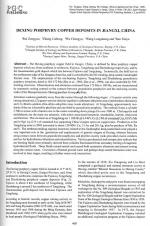Добрый день, Коллеги. Важное сообщение, просьба принять участие. Музей Ферсмана ищет помощь для реставрационных работ в помещении. Подробности по ссылке
Dexing Porphyry Copper Deposits in Jiangxi, China
The Dexing porphyry copper field in Jiangxi, China, is defined by three porphyry copper deposits which are, from southeast to northwest, Fujiawu, Tongchang and Zhushahong respectively, and by the Guanmaoshan gold deposit which lies between Fujiawu and Tongchang. Technically, the field lies on the southeastern edge of the Jiangnan Anteclise, and is controlled by the NE-trending, deep-seated, Gandongbei fracture zone. The emplacement of the ore-bearing Fujiawu, Tongchang and Zhushahong granodiorite porphyry intrusions, dated at 184-172 Ma (Zhu et ah, 1983; Zhu et al9 1990), was also controlled by NW-trending structures. Mineralisation and alteration continued from 172 Ma to 100 Ma, and are characterised by symmetric zoning centred on the contacts between granodiorite porphyries and the enclosing country rocks of the Mesoproterozoic Shuangqiaoshan Group jrfryllites.
Alteration weakens gradually away from the contact through the following stages: - (1) quartz-sericite zone (strong alteration); (2) quartz-sericite-chlorite-(epidote)-carbonate-anhydrite zone (intermediate alteration); and (3) chlorite-epidote-illite-albite-anhydrite zone (weak alteration). At Tongchang, approximately two-thirds of the ore is hosted by phyllites and one-third by granodiorite porphyry. The orebody forms a cylinder 2 500 m across with a barren core in the centre extending down plunge for over 1000 m. Chalcopyrite and molybdenite are the main ore minerals, with minor associated tennantite, tetrahedrite, bornite, chalcocite andelectrum. The ore reserves at Tongchang are 1 168 Mt@ 0.446% Cu (5.2 Mt of contained Cu), 0.01% Mo and 0.19g/t Au (215 t of contained Au) supporting China's largest open-cut copper mine. Production at the Tongchang mine in 2003 amounted to about 120 000 t Cu, 5 t Au and 20 t Ag, plus by-products of Mo, Re and S. The northeast striking regional structures related to the Gandongbei deep-seated fault zone played a very important role in the generation and emplacement of granitic magma at Dexing, whereas fractures along contact zones between granodiorite porphyries and phyllite country rocks provided crucial conduits and loci for hydrothermal alteration and mineralisation. Various geochemical and isotopic data indicate that ore-forming fluids were primarily derived from volatiles fractionated from secondary boiling of magmatic hydrothermal fluids. These fluids carried metals and caused both symmetric alteration and mineral zoning along the contact zones. Circulation of heated ground water and perhaps deep-seated formation water was involved in later stages, resulting in further water-rock interactions.




